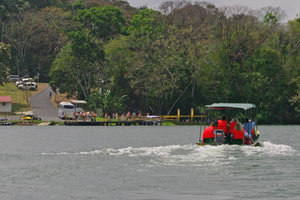Advertisement
Published: November 29th 2015

 Tourists on Chagres River
Tourists on Chagres River
Modern resource for EmberaI am writing this on the plane from Panama to Houston, because our last day was a full one. We drove to Gamboa where a small dock serviced small motor boats (10 passengers). Equipped with bright orange foam vests (not actually life-saving vests, according to the markings), we sped up the
Chagres River for 10-15 minutes to
Puru. Our hosts were
Embera Indians.
Greeting our arrival were musicians (drums and flutes), helpful young men and women, and lots of children. Pedro proudly told us on the bus on earlier days that he helped them build the small dock and new cement stairs up to their village. (This was to meet
Caravan Tours standards; seems that Caravan frequently invests in achieving their standards for tours.)
In a large, square, thatched, open-air building, we sat on benches around three sides. (Crafts for eventual purchase were on the fourth side.) Pedro introduced the Chief (64) who wore silver bracelets and a silver crown, and the Assistant chief (22), who explained all the cultural things we saw. The oldest member of the community is a former chief, is 95, and lives with his daughter in Panama City. In 1958 he moved this village from the
Darien region 
 Embera Welcome
Embera Welcome
Music for disembarkationwhere there was too much danger from the
FARC. There are twelve homes and twenty-eight people (adults?) who live in this village, one of about a dozen in this National Park. They are not allowed to farm or hunt, so they live from tourism – and do a good job.
After his introduction, the Chief came to each person and shook our hands. A history talk (all translations by Pedro) was provided by the young Assistant Chief, who sent around artifacts such as a spear, plants used as dyes, and an unfinished basket. He also had children bring around laminated photos showing how, over twenty years, the Embera helped train US astronauts to survive if they landed in a jungle.
He described the traditional clothing that they were all wearing, giving the names and explaining about materials. The Chief volunteered to model for the male costume, as it seemed the man designated didn’t turn up. A young woman modeled the female costume. Mainly women make the clothes, but some men are learning to bead.
A sample of each craft was brought around, accompanied with explanations of how they were made. Unusual is what they call “
vegetable ivory”, the

 Traditional dance
Traditional dance
Young women proud of their cultureseed of a tree which they carve into animals (mainly) about the size of a small orange. To me it is creamer than ivory, and I was reluctant to buy it in case it would crack in dry Calgary. When we were invited to buy crafts, I chose a lovely basket “bowl” in natural yellow, orange, red on a white background.
But before that we were treated to dances, mostly by the young women. They danced around the building’s centre pole, in a line with minimal steps, accompanied by their own singing. For the second last dance, members of our group, including Joyce, were individually invited to join in.
In addition to the crafts, we were offered “tattoos”, for $2, made by drawing on the skin, expected to last about ten days. Remembering my
henna-ed hand decorated for the wedding of Sitar’s daughter, I offered my arm for a “bracelet”. With a double-pronged instrument the design was drawn in a diamond pattern around the lower forearm. All the Embera were tattooed, especially the young woman doing the painting. My arm was a bit sweaty so the design is a bit fuzzy.
We wandered around the village; their

 Embera house
Embera house
Cool and spacioushouses are on stilts, about 4 – 5 feet high, and we could see into the single large room. These houses are currently inhabited, one even had a small (propane?) fridge; but most of the village is a bit farther away. Grass covered most of the ground - the Embera do live lightly on the earth. Pedro told us they get free schooling; the parents take the children to the small dock where they get the bus every day, and parents collect them again at the end of the day.
This was a most enjoyable morning. Back to the hotel for lunch, then shopping at the grocery store for liquor to take home, packing, swimming and shower. Soon it was time for our departure for the farewell dinner. Pedro announced our surprise destination as the observation building at the Pedro Miguel locks, where we spent our first day. The meal was disappointingly similar to the lunch, but the traffic in the locks was fascinating.
As night came on, the number of boats through the locks increased, almost all freighters. Presumably in the day-time priority is given to cruise ships. We enjoyed seeing the freighter crews handling lots of

 Traditional dance
Traditional dance
Very different from Emberasteel cables and moving fairly quickly through the locks. Of course, there were lots of lights, making viewing very clear.
To finish the night we were treated to traditional Panamanian dancing with a four-person band with singers. The band leader explained that the women’s costumes were very personal and an item of pride, costing about $5000. Their extensive gold neck-pieces are handed down. Pedro rather spoiled it later by proudly saying that Caravan owns these and all costumes seen on the trip, to ensure quality control.
View
">video of our visit to the Embera village.
















